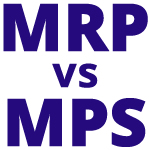
In this article, we explore the differences — and similarities — between manufacturing planning systems MPS (Master Production Scheduling) and MRP (Material Requirements Planning), and the business cases that warrant the use of each.
When to use MPS versus MRP
Demand is a key driver for any inventory planning system, so let’s first start with a few definitions.
Defining Demand
Dependent Demand Item: An item whose demand is dependent on the demand of items above it in the Bill of Materials (BOM). Raw materials and subassemblies that are consumed in the manufacturing process are dependent demand items. These items are often referred to as “lower level” items as they appear in a Bill of Material.
Independent Demand Item: An item whose demand is based on customer demand for that item. These items are often referred to as “top level” items as they frequently have a BOM and are sold. It is important to note that purchased items that are sold are Independent Demand items.
Hybrid Demand Item: Of course, there are items that do not fit into our neat little definitions. Consider items that are both sold and that appear in a BOM. They will have dependent demand, i.e., demand that is driven by items that appear above them in the BOM. And, they will have demand that is independent, i.e., demand that is driven directly by sales. Spares and accessory items come to mind. Often they are used to make the product, but they are frequently sold as service items.
We will use these definitions as we explore MPS and MRP. Now let’s tackle the planning systems.
Defining Planning Systems
Let's start with what I call the “black box” of planning systems: MRP.
MRP answers the question: “How much do we need to buy or make based on how much we have, expect to get and expect to consume. All of this is time phased.
The advice that MRP gives us has two dates
- The date the order is due so that the product arrives in time to meet demand and
- The date the order must be placed based on its lead time so that the supplier or manufacturing has enough time to fulfill it
In addition, MRP takes into account item specific order modifiers such as reorder levels, order up to levels, minimum quantities and order multiples. These fine-tune the planned order often resulting in larger orders that help address variation in demand and improve order economics, balancing the cost of many small orders versus fewer larger orders.
So, what does MPS do? The algorithm in MPS is nearly the same as MRP with one important exception: MPS also takes into account a forecast for the item.
Conventional thinking suggests two rules of thumb that on the surface sound good but in practice are very difficult to achieve:
- Independent demand items should be MPS items, so we can drive their plan with a sales forecast
- Dependent demand items should be MRP planned items as their demand is driving items above them in the BOM and ultimately MPS items
This sounds good in a text book, but in practice and in my experience, the biggest barrier to adopting MPS is the creation and maintenance of the forecast. Forget the idea of relying on statistical techniques to develop the forecast. While a statistical forecast can serve as a starting point, human intervention is always (yes, always) required to fine tune the forecast based on long term and short term shifts in the business plan that are not reflected in the historical data. Historical demand for an item will reflect seasonality, but it cannot reflect the timing of a new product that will be introduced in the coming year that will cannibalize the sales of an existing product. It also will not reflect a sales plan for three major promotions in the coming year when there were only two last year. Forecasts must always be tweaked for information that is not reflected in historical data.
Real world rule number one: keep it simple and justify the addition of complexity
This brings us to the first reason for using MRP to plan an item: MRP is simple. No, the algorithm is not simple, quite the opposite, but using MRP to plan an item is simple. In practice it is almost “set it and forget it." As long as you have defined appropriate order modifiers (reorder level, outer up to level, order multiple etc.) and you have an accurate lead time and inventory, MRP will do a very good job creating advice in the form of planned orders that ensure material is available when it is needed while keeping inventory to a minimum. Oh, and what about setting those values for reorder level and order up to level? A good MRP system will have utilities that can look back at historical consumption, recommend values for these settings, and perform the update for you.
This sounds great for those lower level dependent demand items. But, can MRP plan top level saleable items? In many cases the answer is yes. Consider items that have relatively steady demand over time. Often it is sufficient to set reorder levels and order up to levels for them and simply let MRP ensure that when availability drops below the reorder level, we order enough to get us back to the order up to level.
Could all items go through MRP? The answer to that question is also yes, and many companies do, but there are significant advantages to MPS and its ability to include a forecast in the planning algorithm.
Three MPS versus MRP scenarios to consider
Scenario 1: Assemble-to-order with long lead time components
Consider the assemble-to-order manufacturer (also known as make-to-order) that takes an order on Monday for an item that will be assembled during the week and shipped on Friday. I have one client that does this next day. However, in the BOM there are numerous items and subassemblies that have lead times that exceed the the shop’s lead time for the saleable item. We may offshore key components that take weeks to procure. Yes, one way to handle this is to plan the lower level items using MRP and set order up to levels that ensure we will always have plenty of stock on hand to support manufacturing. But, to be effective the order up to level must be sufficient to handle all variability in demand over time. In other words, it must be set to accommodate the highest level of demand anticipated for the saleable items above it. This frequently results in an inflated order up to level to handle “just in case” demand. Translation: more inventory.
However, when we plan the top level items — I like to refer to them as business driver items — with MPS and set forecasts that go months into the future, lower level items can have very low order up to levels because MPS planned orders, based on their forecast, are seen as demand for the lower level MRP items. In other words, the planned orders generated by MPS drive MRP.
This is especially valuable for purchasing those long lead time component items that are so problematic and cannot be expedited in a pinch. A forecast for a saleable item three months from now results in an MPS planned production order for that make-to-order item that is scheduled to start and is due three months out. We are likely to never release this MPS planned order to the shop; that is not why it was generated. In three months we expect to land the real demand in the form of make to order sales orders, and we will build to that. No, the MPS planned order three months out drives the planning of MRP items so that the key component with a 60-day lead time can be ordered in the coming month to arrive in time to accommodate the anticipated demand for the saleable item. Now, when the shop lands the real order the long lead time components are in stock.
Put another way: “The forecast of an MPS item results in planned production orders that are the demand driver for the purchasing plan of lower level long lead time items.”
Scenario 2: Seasonal Demand
The reorder level and order up to level we’ve been discussing enables MRP to be very effective at ensuring we maintain a specified level of inventory availably for a given item. We even noted that good MRP systems have utilities that can suggest and update these values based on historical information. We could potentially handle seasonality by resetting these numbers several times throughout the year, but this may be a bit onerous. And what about new items that do not yet have sufficient history upon which to calculate these values?
MPS, on the other hand, is well suited for accommodating seasonal demand patterns. Once again, we should set key business driver items to MPS and develop forecasts that reflect the seasonal nature of each. The planned orders that MPS generates then serve as demand for lower level MRP planned items. By extension, their plan accommodates the seasonality of the forecast for the higher level items in whose BOMs they appear.
Scenario 3: Promotional demand
Expected bumps in demand due to product promotions are not something that MRP is designed to a handle. It is perfectly suited to MPS and its capability to accommodate forecasts. It also highlights the reason some firms struggle to implement MPS: someone must be responsible for managing forecasts and reaching out — well in advance — to sales and marketing to determine what their pricing and promotion plan is for the coming year and how it will impact demand. The end result is once again usually less about the planned orders for the MPS items and more about the purchasing and manufacturing plan for lower level MRP items that these planned orders drive. By extension, the MRP planned orders for lower level items that appear in the BOM for an MPS item will reflect the peaks and valleys that result from the ebb and flow of demand that results from a sales and marketing campaign.
MRP vs MPS Considerations
- MPS Key Concepts
- Production Plan (Forecast) — must be created, released, maintained
- Forecast Netted
- Cumulative MPS
- Time Fence
- Order Parameters
- Planning Item
- Runs before MRP — Drives MRP
- MPS requires constant attention
- Marketing, operations and purchasing must collaborate around MPS
- Requires leadership and maintenance and a cultural shift
- MRP Key Concepts
- Demand and Order Parameter Driven — Can only plan to order parameters and actual supply and demand
- No Forecast
- “Black Box” Planning System — makes it easy to implement and operate
- Easy and Simple, Hands-Off
Final thoughts
Keep it simple and justify the addition of complexity. Start with the premise that all items can be planned through MRP, and then justify the overhead involved in managing specific items through MPS, keeping in mind that no forecast is free. Someone will have to tweak an MPS item’s forecast which is built on information that is not knowable based on historical demand.
Understand also that the most common reasons for using MPS to plan an item have nothing to do with the planned order that MPS generates. Sure, the forecast can accommodate seasonality and variation for pricing and promotion, but the resulting planned MPS orders may never be released, especially in a make-to-order environment. Rather, they serve to translate the forecast for the top level “business driver” items into purchasing and production plans for lower level items that frequently have long lead times, so that when we have to make a top level quickly all of the components are available.
Remember...
MPS Execution Sequence: MPS drives MRP

